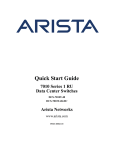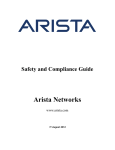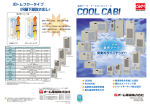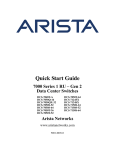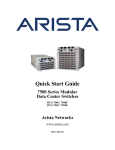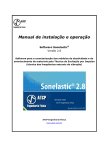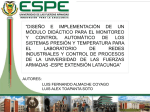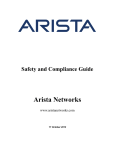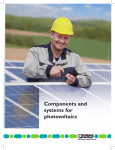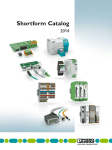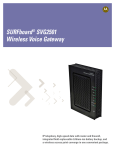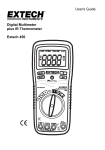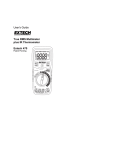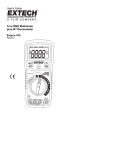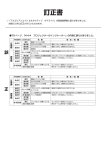Download 7000 2RU QSG PDF
Transcript
Quick Start Guide 7000 Series 2 RU Data Center Switches DCS-7050SX-128 DCS-7050TX-128 DCS-7250QX-64 Arista Networks www.arista.com PDOC-00039-07 Headquarters Support Sales 408 547-5500 408 547-5502 866 476-0000 408 547-5501 866 497-0000 www.arista.com [email protected] [email protected] 5453 Great America Parkway Santa Clara, CA 95054 USA © Copyright 2015 Arista Networks, Inc. The information contained herein is subject to change without notice. Arista Networks and the Arista logo are trademarks of Arista Networks, Inc in the United States and other countries. Other product or service names may be trademarks or service marks of others. Table of Contents Overview..........................................................................................................................................5 Scope....................................................................................................................................5 Receiving and Inspecting the Equipment ............................................................................5 Installation Process ..............................................................................................................5 Safety Information ...............................................................................................................5 Obtaining Technical Assistance...........................................................................................6 Specifications.......................................................................................................................6 Preparation .......................................................................................................................................7 Site Selection .......................................................................................................................7 Tools Required for Installation ............................................................................................8 Electrostatic Discharge (ESD) Precautions .........................................................................8 Rack Mounting the Switch ..............................................................................................................9 Two-Post Rack Mount .........................................................................................................9 Attaching Mounting Brackets to the Chassis...........................................................................10 Inserting the Switch into the Rack ...........................................................................................10 Four-Post Rack Mount.......................................................................................................11 Extracting the Brackets and Rails ............................................................................................12 Attaching Mounting Brackets to the Chassis...........................................................................13 Expanding the Rails .................................................................................................................14 Assembling the Rails onto the Equipment Rack .....................................................................14 Attaching the Switch to the Rack ............................................................................................15 Cabling the Switch.........................................................................................................................16 Connecting Power Cables ..................................................................................................16 Connecting Serial and Management Cables ......................................................................17 Configuring the Switch ..................................................................................................................18 APPENDIX A — Status Indicators ...............................................................................................19 Front Indicators........................................................................................................................19 Switch Indicators ...............................................................................................................19 Port Indicators....................................................................................................................21 Rear Status Indicators ..............................................................................................................22 APPENDIX B — Parts List...........................................................................................................24 Rack Mount Parts.....................................................................................................................24 Four-Post Rack Mount Parts..............................................................................................24 Two-Post Rack Mount Parts ..............................................................................................24 Cables.......................................................................................................................................24 APPENDIX C — Front Panel .......................................................................................................25 APPENDIX D — Rear Panel ........................................................................................................27 7000 Series 1 RU – Gen 3 Quick Start Guide PDOC-00039-07 iii iv Arista Networks Copyright 2015 Chapter 1: Overview Chapter 1 Overview 1.1 Scope This guide is intended for properly trained service personnel and technicians who need to install the following Arista Networks Data Center Switches: • • DCS-7050SX-128 DCS-7050TX-128 • DCS-7250QX-64 Important! Only qualified personnel should install, service, or replace this equipment. 1.2 Receiving and Inspecting the Equipment Upon receiving the switch, inspect the shipping boxes and record any external damage. Retain packing materials if you suspect that part of the shipment is damaged; the carrier may need to inspect them. If the boxes were not damaged in transit, unpack them carefully. Ensure that you do not discard any accessories that may be packaged in the same box as the main unit. Inspect the packing list and confirm that you received all listed items. Compare the packing list with your purchase order. Appendix B provides a list of components included with the switch. 1.3 Installation Process The following tasks are required to install and use the switch: Step 1 Step 2 Step 3 Step 4 Step 5 Select and prepare the installation site (Section 2.1). Assemble the installation tools listed in Section 2.2. Attach the mounting brackets and install the switch in an equipment rack (Chapter 3). Connect the switch to the power source and network devices (Chapter 4). Configure the switch (Chapter 5). Important! Class 1 Laser Product: This product has provisions to install Class 1 laser transceivers which provide optical coupling to the communication network. Once a Class 1 laser product is installed, the equipment is a Class 1 Laser Product (Appareil à Laser de Classe 1). The customer is responsible for selecting and installing the Class 1 laser transceiver and for insuring that the Class 1 AEL (Allowable Emission Limit) per EN/IEC 6-825, CSA E60825-1, and Code of Federal Regulations 21 CFR 1040 is not exceeded after the laser transceiver have been installed. Do not install laser products whose class rating is greater than 1. Refer to all safety instructions that accompanied the transceiver prior to installation. Only Class 1 laser devices, certified for use in the country of installation by the cognizant agency are to be utilized in this product. Important! Ultimate disposal of this product should be in accordance with all applicable laws and regulations. 1.4 Safety Information Refer to the Arista Networks document Safety Information and Translated Safety Warnings available at: http://www.arista.com/en/support/docs/eos 7000 Series 2 RU Quick Start Guide PDOC-00039-07 5 Chapter 1: Overview 1.5 Obtaining Technical Assistance Any customer, partner, reseller or distributor holding a valid Arista Service Contract can obtain technical support in any of the following ways: • Email: [email protected]. This is the easiest way to create a new service request. Include a detailed description of the problem and the output of “show tech-support”. • Web: www.arista.com/en/support. A support case may be created through the support portal on our website. You may also download the most current software and documentation, as well as view FAQs, Knowledge Base articles, Security Advisories, and Field Notices. • Phone: 866-476-0000 or 408-547-5502. Important! No user serviceable parts inside. Refer all servicing to qualified service personnel. 1.6 Specifications Table 1 lists the specifications of Arista Data Center switches covered by this guide. Table 1: Switch Specifications 6 Size (W x H x D) DCS-7050SX-128 DCS-7050TX-128 DCS-7250QX-64 44.5 x 8.8 x 45.9 cm (19 x 3.5 x 18.1 inches) 44.5 x 8.8 x 45.9 cm (19 x 3.5 x 18.1 inches) 44.5 x 8.8 x 55.3 cm (19 x 3.5 x 21.8 inches) Weight DCS-7050SX-128 DCS-7050TX-128 DCS-7250QX-64 15.1 kg (33 pounds) 15.6 kg (34 pounds) 19.2 kg (42 pounds) Operating Temperature Storage Temperature Operating Altitude Relative Humidity all switches all switches all switches all switches 0° to 40° C (32° to 104° F) -25° to 70° C (-13° to 158° F) 0 to 3,000 meters (0 to 10,000 feet) 5 to 90% Power Input (AC Power) DCS-7050SX-128 / PWR-500AC DCS-7050SX-128 / PWR-750AC DCS-7050TX-128 / PWR-745AC DCS-7250QX-64 / PWR-1100AC DCS-7250QX-64 / PWR-1600AC 100 - 240 VAC, 6.3 - 2.3 A, 50/60 Hz 100 - 240 VAC, 10.0 - 4.0 A, 50/60 Hz 100 - 240 VAC, 10.0 - 4.0 A, 50/60 Hz 200 - 240 VAC, 6.5 - 5.5 A, 50/60 Hz 200 - 240 VAC, 10.0 - 8.4 A, 50/60 Hz Power Draw (Typical / Maximum) DCS-7050SX-128 DCS-7050TX-128 DCS-7250QX-64 235 W / 415 W 570 W / 740 W 622 W / 946 W Arista Networks Copyright 2015 Chapter 2: Preparation Chapter 2 Preparation 2.1 Site Selection The following criteria should be considered when selecting a site to install the switch: • Temperature and Ventilation: For proper ventilation, install the switch where there is ample airflow to the front and back of the switch. The ambient temperature should not go below 0° or exceed 40° C. Important! To prevent the switch from overheating, do not operate it in an area where the ambient temperature exceeds 40°C (104°F). • Airflow Orientation: Determine airflow direction of the four fan modules and two power supply modules on the rear panel. Fan and power supply module handles indicate airflow direction: — Blue Handle: Air Inlet module. — Red Handle: Air Exit module. Figure 1 displays fan and power supply module locations on the rear panel. Their red handles indicate that they are air exit modules. Verify that each module has the same airflow direction. Base the switch orientation on the airflow direction of the modules to assure the air inlet is always oriented toward the cool aisle: — Air Exit modules: orient the rear panel toward the hot aisle. — Air Inlet modules: orient the rear panel toward the cool aisle. If the airflow direction is not compatible with the installation site, contact your sales representative to obtain modules that circulate air in the opposite direction. Fan Module 1 Fan Module 2 Fan Module 3 Fan Module 4 Power Supply Module 1 Power Supply Module 2 Figure 1: Fan and Power Supply (Air Exit) Modules • Rack Space: Install the switch in a 19" rack or cabinet. The switch height is 2 RU. The accessory kit provides mounting brackets for four-post racks. Contact your sales representative to obtain two-post mounting racks. When mounting the switch in a partially filled rack, load the rack from bottom to top, with the heaviest equipment at the bottom. Load the switch at the bottom if it is the only item in the rack. 7000 Series 2 RU Quick Start Guide PDOC-00039-07 7 Chapter 2: Preparation • Power Requirements: Power requirements vary by switch and power supply model. Refer to Table 1 for information regarding your specific system. Two circuits provide redundancy protection. Section 4.1 describes power cable requirements. Important! The power input plug-socket combination must be accessible at all times; it provides the primary method of disconnecting power from the system. • Other Requirements: Select a site where liquids or objects cannot fall onto the equipment and foreign objects are not drawn into the ventilation holes. Verify these guidelines are met: — Clearance areas to the front and rear panels allow for unrestricted cabling. — All front and rear panel indicators can be easily read. — Power cords can reach from the power outlet to the connector on the rear panel. Important! All power connections must be removed to de-energize the unit. 2.2 Tools Required for Installation The following tools and equipment are required to install the switch: Two-Post Rack • • Screws or rack mounting nuts and bolts. Screwdriver Four-Post Rack (Tool-less) No additional equipment required. Four-Post Rack (Conventional) • • Screws or rack mounting nuts and bolts. Screwdriver Accessory kit does not include screws for attaching the switch to the equipment rack. When installing the switch into an equipment rack with unthreaded post holes, nuts are also required to secure the switch to the rack posts. 2.3 Electrostatic Discharge (ESD) Precautions Observe these guidelines to avoid ESD damage when installing or servicing the switch. • • • • • • • 8 Assemble or disassemble equipment only in a static-free work area. Use a conductive work surface (such as an antistatic mat) to dissipate static charge. Wear a conductive wrist strap to dissipate static charge accumulation. Minimize handling of assemblies and components. Keep replacement parts in their original static-free packaging. Remove all plastic, foam, vinyl, paper, and other static-generating materials from the work area. Use tools that do not create ESD. Arista Networks Copyright 2015 Chapter 3: Rack Mounting the Switch Chapter 3 Rack Mounting the Switch Important! The rack mounting procedure is identical for all switches covered by this guide. Illustrations in this chapter depict the mounting of a DCS-7050SX-128 switch. • • Section 3.1 provides instructions for mounting the switch in a two-post rack. Section 3.2 provides instructions for mounting the switch in a four-post rack. After completing the instructions for your rack type, proceed to Chapter 4: Cabling the Switch. 3.1 Two-Post Rack Mount To mount the switch onto a two-post rack, assemble the mounting brackets to the chassis, then attach the brackets to the rack posts. Two-post accessory kits include the following two-post mounting parts: • 2 three-hole mounting brackets Each chassis side has attachment pins that align with bracket holes; the number of pins (six or seven) varies by switch model. Pin orientation is symmetric and equidistant, supporting bracket placements where the flange is flush the front switch panel, flush with the rear panel, or not flush with either panel. Each bracket hole includes a key-opening for placing the bracket flush with the chassis and then locking it into place. Important! Attachment pins must be lock all three upper bracket holes. Figure 2 displays proper bracket mount configuration examples. Front Mount Rear Mount Center Mount Figure 2: Bracket Mount Examples for Two-Post Rack Mount Figure 3 displays improper bracket mount configuration examples. Front bracket hole does not lock into pin Rear bracket hole does not lock into pin Figure 3: Improper Bracket Mount Examples for Two-Post Rack Mount 7000 Series 2 RU Quick Start Guide PDOC-00039-07 9 Chapter 3: Rack Mounting the Switch 3.1.1 Attaching Mounting Brackets to the Chassis This procedure attaches mounting brackets to the switch chassis (Figure 4). Step 1 Align the mounting brackets with the attachment pins to obtain the desired mounting position. Step 2 Place the bracket flush on the chassis with attachment pins protruding through key-openings. Step 3 Slide the bracket toward the front flange until the bracket clip locks with an audible click. Bracket Clip Step 3 Step 1 Bracket Clip Step 2 Attaching the Brackets: Front Mount Figure 4: Attaching the Mounting Brackets to the Switch Chassis To remove the mounting bracket from the chassis, lift the front edge of the mounting bracket clip with a flathead screwdriver and slide the bracket away from the front flange (opposite from the installation direction). 3.1.2 Inserting the Switch into the Rack This procedure attaches the switch to the rack (Figure 5). Step 1 Lift the chassis into the rack. Position the flanges against the rack posts. Figure 5: Inserting the Switch into the Rack Step 2 Select mounting screws that fit your equipment rack. Step 3 Attach the bracket flanges to the rack posts. After completing the two-post rack mount, proceed to Chapter 4: Cabling the Switch. 10 Arista Networks Copyright 2015 Chapter 3: Rack Mounting the Switch 3.2 Four-Post Rack Mount The switch is mounted onto a four-post rack by assembling two rails onto the rear posts, sliding the switch onto the rails, then securing the switch to the front posts. The installation kit provides two bracket-rail assemblies. The following four-post mounting parts are extracted from each assembly: • • six-hole mounting bracket rail Each chassis side has attachment pins that align with bracket holes; the number of pins (six or seven) varies by switch model. Pin orientation is symmetric and equidistant, supporting bracket placements where the flange is flush the front switch panel, flush with the rear panel, or not flush with either panel. Each bracket hole includes a key-opening for placing the bracket flush with the chassis and then locking it into place. Important! Attachment pins must be lock all six bracket holes. Figure 6 displays proper bracket mount configuration examples. Front Mount Rear Mount Off-set Mount Figure 6: Bracket Mount Examples for Four-Post Rack Mount Figure 7 displays an improper bracket mount configuration example. Bracket not attached by at least 6 pins Figure 7: Improper Bracket Mount Example for Four-Post Rack Mount Off-set mount is always an improper bracket mount configuration on switches that have six attachment pins on each side. 7000 Series 2 RU Quick Start Guide PDOC-00039-07 11 Chapter 3: Rack Mounting the Switch 3.2.1 Extracting the Brackets and Rails Figure 8 displays a bracket-rail assembly and the component pieces (bracket and rail) that are extracted from the assembly. Each assembly must be separated into its component pieces before mounting the switch into a four-post rack. The two assemblies supplied with the switch are identical + Bracket-Rail Assembly Rail Bracket Figure 8: Bracket-Rail Assembly – Before and After Extraction This procedure separates a bracket-rail assembly into its component pieces. Step 1 Grip the rail with your right hand, as shown in Figure 9-Left. Pull the bracket flange away from the rail flange with your left hand until the bracket clip catches on the rail (Figure 9-Right). If the bracket flange resists initially, verify the thumb screw on the bracket flange is not attached to the rail flange. Rail (Grip here) Inset A Inset A Inset B Thumb Screw Bracket Flange Inset B Locking Clip Rail Flange Locking Clip Figure 9: Extracting the Bracket-Rail Assembly Step 2 While pressing the locking clip on the bracket (Figure 9-Right), resume pulling the bracket from the rail until the separation is complete. Step 3 Repeat the procedure for the other assembly. 12 Arista Networks Copyright 2015 Chapter 3: Rack Mounting the Switch 3.2.2 Attaching Mounting Brackets to the Chassis Figure 10 displays the front bracket alignment for mounting the switch into a four-post rack. Attaching the Brackets: Front Mount Figure 10: Attaching the Mounting Brackets to the Switch Chassis This procedure attaches mounting brackets to the switch chassis as depicted by Figure 11. Step 1 Align the mounting brackets with the attachment pins to obtain the desired mounting position. Step 2 Place the bracket flush on the chassis with attachment pins protruding through key-openings. Step 3 Slide the bracket toward the front flange until the bracket clip locks with an audible click. Bracket Clip Step 1 Step 3 Bracket Clip Step 2 Figure 11: Attaching the Mounting Brackets to the Switch Chassis To remove the mounting bracket from the chassis, lift the front edge of the mounting bracket clip with a flathead screwdriver and slide the bracket away from the front flange (opposite from the installation direction). 7000 Series 2 RU Quick Start Guide PDOC-00039-07 13 Chapter 3: Rack Mounting the Switch 3.2.3 Expanding the Rails The rail is a two-piece mechanism. The rail length is adjusted by gliding the rail-rod inside the rail-slide. The rail clip prevents the extension of the rail beyond the maximum supported distance between front and rear rack posts. When the rail is contracted, the rail clip is closest to the slide end. The rail is initially contracted and must be expanded to attach onto the rack. This procedure expands the rails from their contracted state: Step 1 Grip the slide end with your left hand the rod end with your right hand (Figure 12-Left). Step 2 Pull the ends apart until the rail-clip makes and audible click (Figure 12-Right). Rail (contracted) Rail (Expanded) Rail-Slide end (grip with left hand) Inset A Rail-Rod end Rack Plugs (grip with right hand) Rail Clip Inset A Figure 12: Expanding the Rails 3.2.4 Assembling the Rails onto the Equipment Rack A rail connects a front post to a rear post. Each end has two rack plugs (Figure 12-Right, inset A). Rails are installed into a rack by inserting the plugs into rack slots. To install rails into posts with threaded or rounded holes, remove all plugs on both sides of the rails, then install the rails with bolts that fit the rack. This procedure attaches the rails to a four-post rack: Step 1 Attach rail to the right rear rack post by inserting rod-end rack plugs into post slots (Figure 13, inset A). The slide assembly must be inside the right posts, relative to the left rack posts. If the rack plugs were previously removed, use bolts to attach the rail to the rack. Step 2 Attach the slide end of the rail to the front post by extending the rail end past the post, then contracting the rail while guiding the rack plugs into the post (Figure 13, inset B). Step 3 Repeat step 1 through step 2 for the left posts. Ensure the rails are on the same horizontal level. Inset A Inset B Inset B Inset A Figure 13: Attaching the Rails 14 Arista Networks Copyright 2015 Chapter 3: Rack Mounting the Switch 3.2.5 Attaching the Switch to the Rack After the rails are installed, the switch slides on the rails into the rack. Each bracket includes a thumb screw that attaches the switch to the rail Step 1 Lift the switch into the rack and insert the mounting brackets into the slide rails. Figure 14: Inserting the Switch onto the Rails Step 2 Slide the switch on the rails, toward the rear posts, until the mounting bracket flanges are flush with the rail flanges attached to the rack posts. Step 3 Attach the bracket flanges to the rack post using the quick-release thumb screws supplied with the brackets. Inset A Inset A Figure 15: Attaching the Switch to the Rack Posts After completing the four-post rack mount, proceed to Chapter 4: Cabling the Switch. 7000 Series 2 RU Quick Start Guide PDOC-00039-07 15 Chapter 4: Cabling the Switch Chapter 4 Cabling the Switch 4.1 Connecting Power Cables Important! Installation of this equipment must comply with local and national electrical codes. If necessary, consult with the appropriate regulatory agencies and inspection authorities to ensure compliance. The switch operates with two installed power supplies. At least one power supply must connect to a power source. Two circuits provide redundancy protection. Appendix D displays the location of the power supplies on the rear panel of the switch. Important! Read all installation instructions before connecting the system to the power source. • • • Non-Redundant Configuration: Connect power to either of the two power supplies. Redundant Power Supply Configuration: Connect power to both power supplies. Power down the Switch: Remove all power cords and wires from the power supplies. Important! This equipment must be grounded. Never defeat the ground conductor. Important! This unit requires overcurrent protection. Three power supply models (in each air flow direction) are available for 7000 Series 2 RU switches. The power supply (110W, 750W) model number is shown on the label under the handle, and on the label on top of the supply (Figure 16). Model numbers of available power supplies include: • • • • PWR-500AC PWR-745AC PWR-750AC PWR-1100AC Power requirements vary by switch and power supply model. Refer to Table 1 for information regarding your specific system. The AC power supply connects to a circuit that provides the required power. Figure 16 displays an AC power supply, including the power socket on the left side of the module. Figure 16: AC Power Supply The power supplies require power cables that comply with IEC-320 and have a C13 plug. The accessory kit provides two IEC-320 C13 to C14 power cables, each two meters long. 16 Arista Networks Copyright 2015 Chapter 4: Cabling the Switch 4.2 Connecting Serial and Management Cables The accessory kit includes the following cables: • • RJ-45 to DB-9 serial adapter cable. RJ-45 Ethernet cable. Table 2 lists the pin connections of the RJ-45 to DB-9 adapter cable. Table 2: RJ-45 to DB-9 Connections RJ-45 DB-9 RJ-45 DB-9 RTS 1 8 CTS GND 5 5 GND DTR 2 6 DSR RXD 6 3 TXD TXD 3 2 RXD DSR 7 4 DTR GND 4 5 GND CTS 8 7 RTS The front panel contains the console, management, and USB ports. Figure 17 displays the ports on the DCS-7050SX-128 switch. Appendix C displays the front panel of all switches covered by this guide. Console (Serial) Port 46 47 48 USB Port 94 95 Ethernet Management Ports 96 Figure 17: Front Panel Ports Connect the front panel ports as follows: • Console (Serial) Port: Connect to a PC with the RJ-45 to DB-9 serial adapter cable. The switch uses the following default settings: — — — — — 9600 baud No flow control 1 stop bit No parity bits 8 data bits • Ethernet Management Port: Connect to 10/100/1000 management network with RJ-45 Ethernet cable. • USB Port: The USB port may be used for software or configuration updates. Caution Excessive bending can damage interface cables, especially optical cables. 7000 Series 2 RU Quick Start Guide PDOC-00039-07 17 Chapter 5: Configuring the Switch Chapter 5 Configuring the Switch Arista switches ship from the factory in Zero Touch Provisioning (ZTP) mode. ZTP configures the switch without user intervention by downloading a startup configuration file or a boot script from a location specified by a DHCP server. To manually configure a switch, ZTP is bypassed. The initial configuration provides one username (admin) accessible only through the console port because it has no password. When bypassing ZTP, initial switch access requires logging in as admin, with no password, through the console port. Then you can configure an admin password and other password protected usernames. This manual configuration procedure cancels ZTP mode, logs into the switch, assigns a password to admin, assigns an IP address to the management port, and defines a default route to a network gateway. Step 1 Provide power to the switch (Section 4.1). Step 2 Connect the console port to a PC (Section 4.2). As the switch boots without a startup-config file, it displays the following through the console: The device is in Zero Touch Provisioning mode and is attempting to download the startup-config from a remote system. The device will not be fully functional until either a valid startup-config is downloaded from a remote system or Zero Touch Provisioning is cancelled. To cancel Zero Touch Provisioning, login as admin and type 'zerotouch cancel' at the CLI. localhost login: Step 3 Log into the switch by typing admin at the login prompt. localhost login:admin Step 4 Cancel ZTP mode by typing zerotouch cancel. IMPORTANT: This step initiates a switch reboot. localhost>zerotouch cancel Step 5 After the switch boots, log into the switch again by typing admin at the login prompt. Arista EOS localhost login:admin Last login: Fri Mar 15 13:17:13 on console Step 6 Enter global configuration mode. localhost>enable localhost#config Step 7 Assign a password to the admin username with the username secret command. localhost(config)#username admin secret pxq123 Step 8 Configure a default route to the network gateway. localhost(config)#ip route 0.0.0.0/0 192.0.2.1 Step 9 Assign an IP address (192.0.2.8/24 in this example) to an Ethernet management port. localhost(config)#interface management 1 localhost(config-if-Ma1/1)#ip address 192.0.2.8/24 Step 10 Save the configuration by typing write memory or copy running-config startup-config. localhost#copy running-config startup-config When the management port IP address is configured, use this command to access the switch from a host, using the address configured in step 9: ssh [email protected] Refer to the Arista Networks User Manual for complete switch configuration information. 18 Arista Networks Copyright 2015 Appendix A: Status Indicators Appendix A Status Indicators A.1 Front Indicators A.1.1 Switch Indicators Front panel LEDs are located on the right side of the chassis and display system, fan, and power supply status. Appendix C displays the front panels of all switches covered by this guide. Figure 18 displays the DCS-7050SX-128 front panel LEDs. Fan Status LED Power Supply 1 Status LED System Status LED Power Supply 2 Status LED 46 47 48 94 95 96 Figure 18: System Status Indicators 7000 Series 2 RU Quick Start Guide PDOC-00039-07 19 Appendix A: Status Indicators Table 3: Switch Indicators LED States (Front) LED Name System Status LED LED State Blinking Green System is powering up. Green Normal operations. Due to power supply and fan redundancy, this LED will remain green if a single fan or power supply is missing or in a failed state. Blue The locator function is active. Amber Two or more fans (any combination of fan modules or PSU fans) are disconnected or malfunctioning. The switch will automatically execute a “graceful shutdown” shortly. Green All fan and power modules are operating normally. Amber Single fan module is removed or malfunctioning. It is also amber when a PSU is completely removed or has a stuck fan rotor. Red Two or more fans (any combination of fan modules or PSU fans) are disconnected or malfunctioning. The switch will automatically execute a “graceful shutdown” shortly. Green PSU is functioning and fully operational. AC is present, Aux output is ON, and Main output is ON. Off PSU has been removed or is not operating properly due to AC cord being unplugged, its fan rotor being stuck, or an internal fault. Fan Status LED PSU [1:2] Status LED 20 Device Status Arista Networks Copyright 2015 Appendix A: Status Indicators A.1.2 Port Indicators Port LEDs, located in the vicinity of their corresponding ports, provide link and operational status. Figure 19 displays the Port LED location on the DCS-7050SX-128 switch. Appendix C displays the port LED locations of all switches covered by this guide. 1 2 3 49 50 51 4 5 6 7 8 9 10 11 56 57 58 59 Port 1 LED Port 2 LED 52 53 54 55 Port 49 LED Port 50 LED Figure 19: Port LEDs Table 4 provides status conditions that correspond to port LED states. Port LED behavior for QSFP+ and SFP+ ports is consistent. Table 4: Port LED States (Front) LED State Status Off Port link is down. Green Port link is up. Yellow Port is software disabled. Flashing Yellow Port failed diagnostics. 7000 Series 2 RU Quick Start Guide PDOC-00039-07 21 Appendix A: Status Indicators A.2 Rear Status Indicators Fan and power supply modules are accessed from the rear panel. Each fan and power supply module contains an LED that reports the module status. Appendix D displays the rear panel of all switches covered by this guide. Fan Status LEDs are on the fan modules, as displayed in Figure 20. Module Installation Indicator Fan Status LED Figure 20: Fan Status LED The module installation indicator is green when the fan module is properly installed or red when the module is not fully installed. Table 5 provides status conditions that correspond to fan status LED states. Table 5: Fan Status LED States (Rear) LED State Status Off The fan module is inserted but not receiving power – it may not be properly seated. Green The fan is operating normally. This LED state is exclusive to its fan module, and independent of the states of its neighboring fans and power supplies. Red The fan has failed. The Power Supply Status LEDs are on the power supply modules, as displayed in Figure 21. Power Supply Status LED Figure 21: Power Supply Status LED 22 Arista Networks Copyright 2015 Appendix A: Status Indicators Table 6 provides status conditions that correspond to power supply status LED states. Table 6: Power Supply Status LED States (Rear) LED State Status Off Power supply not connected to AC power and not inserted fully. Green Power supply is operating normally. Amber Power supply has overheated or failed. Blinking Amber Fault of any kind – electrical, thermal, fan, or no AC cable attached. This power supply fault can be due to high or low voltage, current, temperature, stuck rotor, faulty cables, improper insertion into chassis, or internal damage. Blinking Green Standby mode – Power supply main is turned off, and Aux is on. AC is present, Aux output is on, and Main output is turned off. Important! You can narrow down the error condition by logging in to the switch to view the specific device state. Refer to the Arista User Manual’s Switch Environment Control chapter, under the topic Viewing Environment Status, for further information on the show environment commands. 7000 Series 2 RU Quick Start Guide PDOC-00039-07 23 Appendix B: Parts List Appendix B Parts List Each switch provides an accessory kit that contains parts that are required to install the switch. This appendix lists the installation parts contained in the switch accessory kit. B.1 Rack Mount Parts Four-post rack mount parts are provided in the accessory kit. Two-post rack mount parts are available through your sales representative. B.1.1 Four-Post Rack Mount Parts Bracket-Rail Assemblies (2) Figure 22: Four-Post Rack Mount Parts B.1.2 Two-Post Rack Mount Parts Mounting Brackets (Three Hole) Figure 23: Two-Post Rack Mount Parts B.2 Cables Table 7: Switch Cables Quantity Warning! Description 2 Power cables: IEC-320/C13-C14, 13 A, 250 V, 2 meter 1 RJ-45 Patch Panel Cable, 2 meter 1 RJ-45 to DB9 Adapter Cable, 2 meter All provided power cables are for use only with Arista products. 警告 すべての電源コードは提供する製品で使⽤するためだけを⽬的としている。 電源コードの他の製品での使⽤の禁⽌ Arista が提供するすべての電源コードは、Arista の製品でのみ使⽤してください。 24 Arista Networks Copyright 2015 Appendix C: Front Panel Appendix C Front Panel This appendix displays the front panel of all switches covered by this guide. DCS-7050SX-128 USB Flash Port Console (Serial) Port Power Supply 2 Status LED Power Supply 1 Status LED Fan Tray Status LED System Status LED 1 2 3 49 50 51 4 5 52 53 6 7 8 54 55 9 10 11 12 13 14 15 16 17 18 19 20 21 22 23 24 25 26 27 28 29 30 31 32 33 34 35 36 37 38 39 40 41 42 43 44 45 46 47 48 56 57 58 59 60 61 62 63 64 65 66 67 68 69 70 71 72 73 74 75 76 77 78 79 80 81 82 83 84 85 86 87 88 89 90 91 92 93 94 95 96 Ethernet Management 2 Port Ethernet Management 1 Port Figure 24: DCS-7050SX-128 Front Panel DCS-7050TX-128 USB Flash Port Console (Serial) Port Power Supply 2 Status LED Power Supply 1 Status LED Fan Tray Status LED System Status LED 1 2 3 4 5 6 7 8 9 10 11 12 13 14 15 16 17 18 19 20 21 22 23 24 25 26 27 28 29 30 31 32 33 34 35 36 37 38 39 40 41 42 43 44 45 46 47 48 97 98 99 100 49 50 51 52 53 54 55 56 57 58 59 60 61 62 63 64 65 66 67 68 69 70 71 72 73 74 75 76 77 78 79 80 81 82 83 84 85 86 87 88 89 90 91 92 93 94 95 96 101 102 103 104 Ethernet Management 2 Port Ethernet Management 1 Port Figure 25: DCS-7050TX-128 Front Panel 7000 Series 2 RU Quick Start Guide PDOC-00039-07 25 Appendix C: Front Panel DCS-7250QX-64 USB Flash Port Console (Serial) Port Power Supply 2 Status LED Power Supply 1 Status LED Fan Tray Status LED System Status LED 7250QX-64 Ethernet Management 2 Port Ethernet Management 1 Port Figure 26: DCS-7250QX-64 Front Panel 26 Arista Networks Copyright 2015 Appendix D: Rear Panel Appendix D Rear Panel This appendix displays the rear panel of all switches covered by this guide. All Models Fan Module 1 Fan Module 2 Fan Module 3 Fan Module 4 Power Supply Module 1 Power Supply Module 2 Figure 27: Rear Panel 7000 Series 2 RU Quick Start Guide PDOC-00039-07 27 Appendix D: Rear Panel 28 Arista Networks Copyright 2015





























